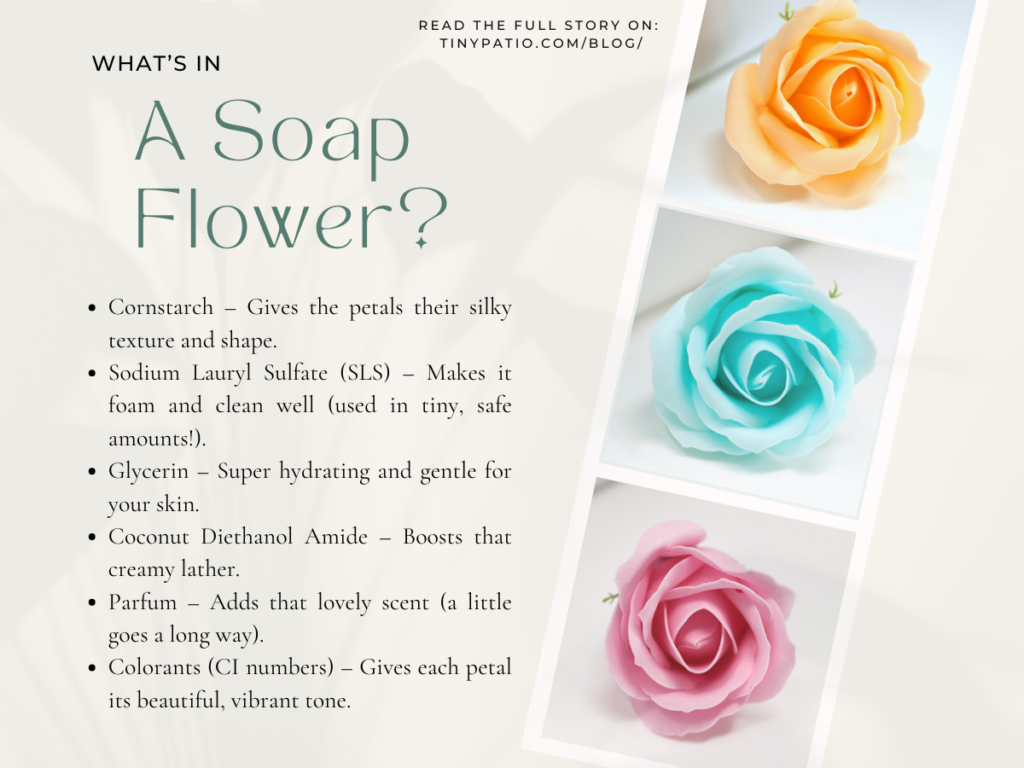Unlike regular bar soaps, soap flowers are made from a special soap base that’s soft, moldable, and gentle on skin—perfect for creating those lifelike blossoms you love.
At Tiny Patio, we love sharing not just our products, but also the story behind them. So today, we’re peeling back the petals (pun totally intended!) to show you exactly what goes into making our lovely vegan soap flowers (our lovely soap flower gift box is available right here). Whether you’re ingredient-curious, have sensitive skin, or just love knowing what you’re gifting—this one’s for you.
First things first: how is soap made?
Soap making is a mix of art and science. At its heart, soap is made by mixing oils or fats with an ingredient called lye (a strong alkaline substance). This process is called saponification, and it’s how we turn liquid oils into a cleansing, solid soap.
But in the case of soap flowers, we’re not making your everyday bar soap. These pretty petals are made from a special type of soap base that allows us to shape and mold the soap into delicate flowers, while still keeping them safe for the skin and beautifully scented. Think of it like crafting soap clay—smooth, flexible, and easy to work with, yet totally usable in a bath.
Now let’s dive into the actual ingredients used in our soap flowers. We’ll keep it simple and honest—no science degree needed!

Ingredient Deep Dive: What’s in One of Our Soap Flowers?
Here’s the ingredient list from one of our most popular soap flowers, and what each one does:
- Zea Mays (Cornstarch)
What it is: Cornstarch is a soft, white powder made from—you guessed it—corn!
What it does: It helps give the soap flower a silky, smooth feel. It also absorbs moisture and helps hold the flower’s shape without being heavy.
Is it safe? Yes, it’s completely natural and commonly used in baby powder and even cooking.
Alternative: Sometimes rice starch or arrowroot powder is used instead, but cornstarch is a gentle, widely trusted option.
- Sodium Lauryl Sulfate (SLS)
What it is: A cleansing agent (called a surfactant) that helps soap foam and lather.
What it does: It’s what makes your soap bubble and gives you that squeaky clean feel.
Is it bad? This ingredient gets a bit of a bad rep sometimes. On its own, SLS can be drying if used in large amounts, especially for sensitive skin. But in tiny, rinse-off amounts like in our soap flowers, it’s considered safe by health authorities.
Alternative: If you’re looking for a gentler alternative, some natural soaps use things like Sodium Coco-Sulfate or Decyl Glucoside—milder surfactants derived from coconut or sugar.
- Polyvinyl Alcohol (PVA)
What it is: A synthetic, water-soluble film-forming agent. It sounds super science-y, but it’s used in loads of everyday things—from contact lens solutions to face masks.
What it does: Helps bind everything together so the soap holds its petal shape. It also makes the petals flexible and smooth.
Is it safe? Yes, PVA is non-toxic and generally considered safe for use in cosmetics and skincare.
Alternative: In solid soaps, this ingredient usually isn’t needed. But for shaped soaps like these, there’s currently no perfect natural substitute that does the same job as well.
- Glycerol (aka Glycerin)
What it is: A clear, sweet, natural substance made from plant oils or as a by-product of soap making.
What it does: Glycerin is a humectant, which means it helps draw moisture into the skin. That’s why it’s found in almost every skincare product out there—it’s super hydrating and gentle.
Is it safe? Absolutely! Glycerin is one of the most skin-friendly ingredients out there.
Alternative: No need—glycerin is already a great choice.
- Coconut Diethanol Amide
What it is: A thickening and foaming agent derived from coconut oil.
What it does: It helps the soap foam nicely and gives a rich, creamy texture when used in water. It also acts as a stabilizer to keep all ingredients working together smoothly.
Is it safe? It’s generally considered safe in rinse-off products, though some people with very sensitive skin prefer to avoid certain coconut-derived chemicals.
Alternative: Some gentler alternatives include coconut glucoside or oat-based foaming agents.
- White Mineral Oil (Petroleum-based)
What it is: A highly refined, colorless oil made from petroleum.
What it does: Helps keep the soap flower soft and smooth. It adds a light, silky texture and prevents the soap from drying out too quickly.
Is it bad? This one’s a bit controversial. While cosmetic-grade mineral oil is purified and safe (used in baby oil and lotions), it’s still a petroleum product. If you prefer plant-based, some people look for alternatives like jojoba oil or almond oil.
Alternative: Yes—plant-based oils can sometimes be used instead, though they may change the texture or shelf life of the soap.
- Parfum (Fragrance)
What it is: This is where the beautiful scent comes from! “Parfum” is a term that covers a blend of fragrance ingredients—these can be synthetic or natural.
What it does: Gives the soap flower its lovely, fresh, floral smell.
Is it safe? In small amounts like this, it’s fine for most people. However, if you have a known fragrance allergy, you might want to patch test first or look for fragrance-free products.
Alternative: Essential oils (like lavender or rose) are more natural, but they can still cause irritation in some people. It’s all about balance!
- Colorants (CI 16255, CI 16185, CI 16035, etc.)
What they are: These are color additives, each with a specific number (CI stands for “Color Index”).
What they do: They give the soap its beautiful pinks, purples, blues—basically the “flower” look.
Are they safe? Yes, these are cosmetic-grade and approved for use in soaps and bath products. But if you prefer all-natural colorants, there are plant-based options like beetroot powder or spirulina—though the shades may be more muted.
Alternative: Natural micas, clays, or food-grade dyes (though not as vibrant or long-lasting).
A quick note on safety and skin-friendliness
All the ingredients used in our soap flowers are approved for cosmetic use and are considered safe for most skin types. These products are meant to be enjoyed occasionally—either in a bath, as hand soap, or just as a sweet-smelling treat in your bathroom.
However, if you have extremely sensitive skin or allergies, we always recommend checking the label and doing a patch test. And of course, these soaps are not for eating, no matter how pretty they look!
If you ever have questions about ingredients, allergies, or how to use our products—we’re just a message away. We’re a small business built on community and care, and we love talking about what we do.

